In this post, we will help you use the 3D Viewer app in Windows 11/10. It is developed by Microsoft Corporation for users to view a 3D model as well as animations in real-time. The app has two main features; 3D Viewer and Mixed Reality mode. While the 3D Viewer feature is handy for viewing 3D models with different themes, shading modes, environments, lighting controls, etc., the Mixed Reality mode lets you put a 3D model into the real world using a webcam and record it or take a picture of it.
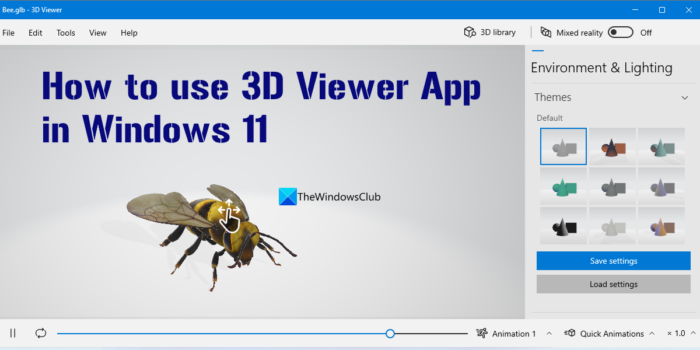
This app was launched as View 3D app and then became Mixed Reality Viewer. Now the app is rebranded and a new name 3D Viewer is given to it along with many improvements, a changed interface, and useful options. You will have options to adjust the color of light for the 3D object, toggle Property Panel, Animation Panel, control with Surface Pen, and more. Let’s take a deep look at the app.
How to use the 3D Viewer app in Windows 11/10
If you want to use the 3D Viewer app in Windows 11, you need to install it from Microsoft Store. It doesn’t come with special requirements so it can be installed without a hassle.
When you open the app interface the very first time, you will see a welcome screen, and then a 3D character will be visible on the main interface.
The app interface is user-friendly and mainly divided into three sections. The main section (or the viewing panel) is for viewing the 3D model or character. You can use the pre-added model or use the Open option present in the File menu to add a model from your Windows 11 computer. Supported 3D file types are OBJ, STL, 3MF, PLY, GLTF, FBX, etc.
The right section shows the Property Panel and the bottom section is there to use the Animation Panel. You can toggle these panels from the View menu and also access other options which include zooming in and out, rotating the 3D model, setting the light intensity, saturation, hue, brightness, etc. Let’s check these panels and available options/sections in detail.
Property Panel in the 3D Viewer app
Property Panel can be considered the most important part of the Microsoft 3D Viewer app. This panel includes lighting options, viewpoints, textures, themes, etc., to view and inspect model data. All the options are present in different categories so you won’t have any difficulty accessing and using the available options. Let’s check what is included in this panel. We will start with the Environment & Lighting category.
Environment & Lighting
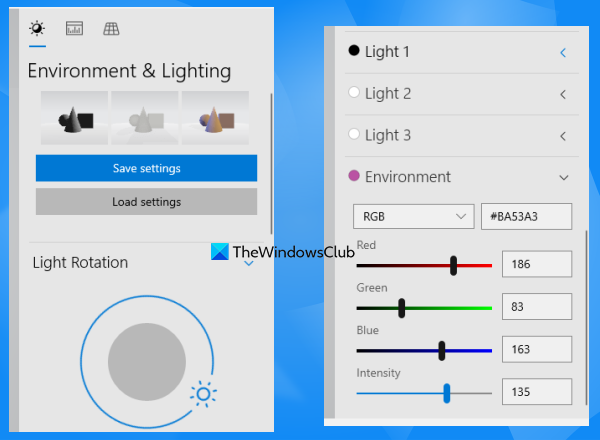
The Environment & Lighting category lets you present the 3D model with different themes, lighting effects, and environment. You can also save the applied settings and load them when needed. It comes with 3 sections which are as follows:
- Themes: Use this section to change the theme of the 3D model. There are a total of 9 themes to use in this section
- Light Rotation: With this section, you can control the lighting for the model from 0 to 360 degrees. Three different lighting options (Light 1, Light 2, and Light 3) are also there with default HSV and RGB values. You can also change the HSV and RGB values for each light option separately
- Environment: In this section, you can set the environment for the 3D model by adjusting the HSV (Hue, Saturation, and Value) and/or RGB (Red, Green, and Blue) values.
There are sliders available to adjust the RGB and HSV values that make it convenient to control the environment and lighting for the model. The intensity level can also be adjusted with a slider.
Stats & Shading
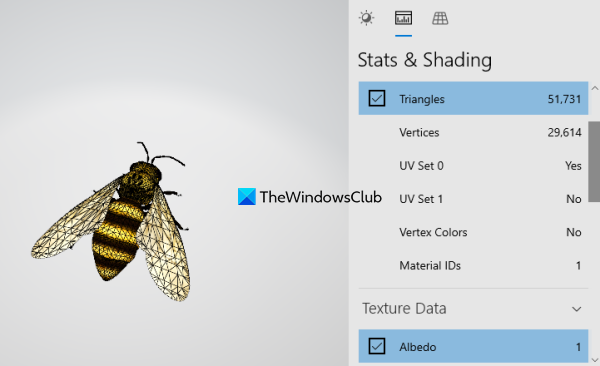
Just next to the Environment & Lighting feature in the Property Panel, you can access the Stats & Shading feature that lets you show/hide Material IDs, UV Set, Triangles, Vertex Colors, and Vertices to the 3D model. The changes are visible in real-time as soon as you select an option. Expand the Mesh Data section to use such options.
In addition to that, there is a Texture Data section in Stats & Shading that you can expand to apply a texture. Available textures are Gloss/Roughness, Normal, Emissive, Specular/Metallic, Occlusion, and more.
Grid & Views
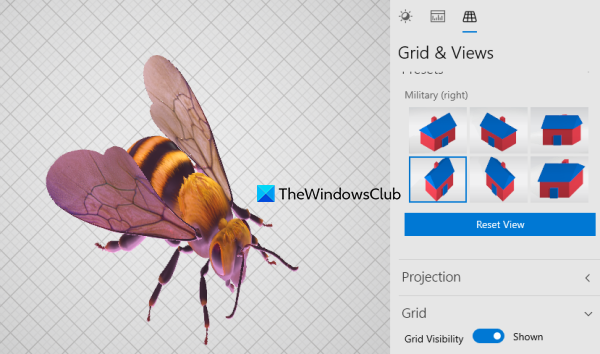
With this section, you are able to show/hide grids in the viewing panel, adjust gridline spacing, and set the frequency of major gridlines. Expand the Grid section to access and use such options.
Along with that, there are Viewpoints and Presets sections present to access and use the camera angles to adjust the projection of the model present in the viewing panel. While the Viewpoints section lets you switch to the Left View, Bottom View, Top View, and Right View angles, the Presets section comes with other camera points for the 3D model.
Related: View 3D models using these free 3D file viewer software for Windows
Animation Panel of 3D Viewer app
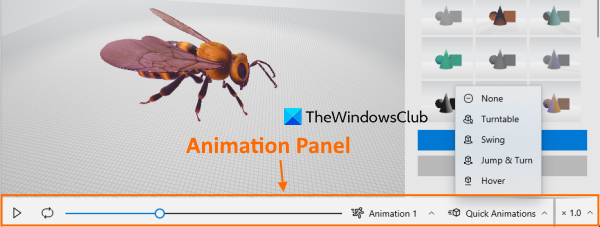
The Property Panel offers many important sections and options to present and view the 3D model. And, the Animation Panel is there to play/pause the animation (if the 3D model supports that), loop the animating model, play the animating model once, and switch to the animation type (if the model supports more than one animation). To show the Animation Panel, use the View menu and it will appear on the bottom part of the app interface.
Apart from animating the model, you can also access the Quick Animations drop-down menu (on the bottom right section) to Swing, Hover, Turntable, or use the Jump & Turn animation effect for your model. Animation speed can also be changed using this panel.
Now let’s talk about the Mixed Reality feature of this app.
Use Mixed Reality View Mode in the 3D Viewer app
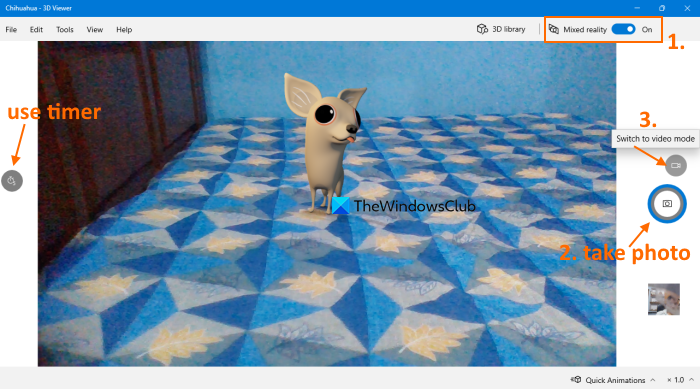
As we mentioned in starting, this app also comes with a Mixed Reality view mode. You can activate or enable it using the Mixed reality button present in the top right corner of the app interface. Once the Mixed Reality mode is activated, it will turn on the webcam and the 3D model will appear in the real world which gives a pretty good augmented reality experience. You can drag and drop the model to any part of the screen or simply tap/click anywhere on the viewing area to place the model. You can also zoom in and out of the model using the mouse wheel.
Once the model is placed in the required area, you can take a photo of it using the Camera icon present in the right section. Before taking the snapshot, you can also set a timer (using the left section) to 2 seconds, 5 seconds, or 10 seconds so that you can set up or make adjustments before you take a picture.
You can also switch to the video mode to keep a recording of the 3D model in the real world and save it to your PC for later use. The snapshots or photos are saved in JPG format and the recording is saved in MP4 format to the Camera roll folder under the Pictures section in your computer.
Other important features of this 3D Viewer app
- 3D library: This is an interesting feature that lets you search for 3D models available online for use. You can perform the search within the app interface and also access models by categories. Available categories are Animals & Insects, Sci-Fi & Fantasy, Cars & Vehicles, Best of Minecraft, etc. Selecting a model will add and show it in the viewing panel
- You can open the Controls box to check Mouse, Pen, Keyboard, and Touch controls supported by this app. Press F1 or use the Help menu to open the Controls box
- Zoom in and out of the 3D model, reset the camera, show/hide the grid, access Shading effects, etc. Use the View menu to access these options. Or else, these options can be accessed and used in other ways. As an example, you can zoom in and out using the mouse wheel, use Shading effects from the Property Panel, etc.
- Save the model as a GLTF Binary file using the File menu
- Export the model as Bitmap, TIFF, JPEG, or PNG image file. You can set the size and resolution and also show/hide the grid for the output image. Use the Export Image option present in the File menu or press Ctrl+E hotkey to export the image
- Open your model with the Paint 3D app for editing. You can add text to your model, apply different effects, add 3D shapes, stickers, etc., using that app. This option is also present in the File menu. No need to mention that you have to install the Paint 3D app to use this option
- Take the 3D print of the model
- Show/hide the welcome screen, switch to the dark mode or light mode for the app, and turn on/off the option to display a mirror image in Mixed Reality view mode. All these options are present under the Settings section of this app.
That’s all about this Microsoft 3D viewer app. Indeed, the app is improved a lot and some crucial options are present in this app that make it one of the best options to view 3D models and inspect their data.
Read next: How to edit 3D OBJ models in Windows 11/10
Does Windows 11 have a 3D Viewer?
Windows 11 doesn’t come with a 3D Viewer app pre-installed. But, you can use the Microsoft Store to download and install the Microsoft 3D Viewer app. This app lets you view common 3D file types, use a 3D library to find and use 3D models, adjust lighting and environment for the 3D model, play the animation, and much more.
How do I use Windows 3D Viewer?
If you want to use the Microsoft 3D Viewer app, then first install it from the Microsoft Store. After that, you can access and use its Property Panel, Animation Panel, 3D library, etc., to view 3D models, visualize the shading modes, etc. You can read this post to get detailed information about this 3D Viewer app to use it with ease.
Read next: How to uninstall the 3D Viewer app on Windows PC.
3D Viewer App not working
Sometimes, while using 3D Viewer App, you run into problems and see an error message. Try these solutions to fix the problem, instantly.
- Disconnect your headset from your PC (both cables) and restart your PC, then reconnect your headset.
- If restarting method fails to work, make sure that your headset is recognized by your PC. You can verify this by selecting Start option, typing device manager in the search box, and then select it in the list. If you find Mixed Reality devices listed, expand it to find, your headset is listed. If it isn’t listed,
- Try plugging the headset into different ports on the PC.
- Check for the latest software updates from Windows Update.
- Uninstall and reinstall Windows Mixed Reality
- Disconnect your headset from your PC (both cables).
- Now, select Settings > Mixed reality > Uninstall. Here, unpair your motion controllers by selecting Settings, then, Devices and finally choosing Bluetooth & other devices. Select each controller, and then select Remove device.
To reinstall Windows Mixed Reality, plug your headset back into your PC.
Please note that Mixed Reality apps and features can be enabled and used only if your device fulfills the minimum hardware requirements. Check if your PC supports Mixed Reality.
Will this come to Windows 10 mobile?
can not download mixed reality portal no matter what I tried
Please advice! I would love this application, but it would be great if we mixed 3d with videos instead of webcam, I tried using OBS virtual webcams, but failed!